All 20 entries tagged Coins In Focus
No other Warwick Blogs use the tag Coins In Focus on entries | View entries tagged Coins In Focus at Technorati | There are no images tagged Coins In Focus on this blog
February 13, 2015
The Social Life of Images in the Social War
In the period 90-88 BC several Italian allies revolted from Roman control, objecting that they contributed resources and troops to the Roman cause while receiving little in return. The assassination of Marcus Livius Drusus, who proposed granting Italian allies Roman citizenship, in 91 BC sparked revolt. The Italians created their own confederation named Italia, with a new capital at Corfinium, which was renamed Italica (see Diodorus Siculus 37.4).
 |
|
Roman Republican Denarius showing Apollo and Roma
(RRC 335/1). © The Trustees of the British Museum
|
The Italians also began to strike their own coinage, which carried a mixture of Roman and non-Roman elements. The coins were denarii, and circulated alongside Roman issues (at least, we find them buried alongside Roman denarii in hoards). Alongside Latin, Oscan was used. Some types derived from Roman coinage; one in particular demonstrates how imagery can shift and change meaning according to context, an idea explored in several other posts on this blog. In c. 96 BC the moneyers at Rome released a type showing the wreathed head of Apollo on the obverse and Roma seated on a pile of shields on the reverse, holding a sword and shield and being crowned by Victory (RRC 335/1-2).
This imagery was then adopted by the Italians during the Social War, but the head of Apollo and the figure of Roma were given a very different meaning. On one type (HN Italy 412a) the laureate head is given a necklace and accompanied by the legend ITALIA: the head has now become the personification of Italia herself. On the other issue (HN Italy 412b), the legend ITALIA is found on the reverse, suggesting that the image of Roma being crowned by Victory has transformed into a triumphant image of Italia.
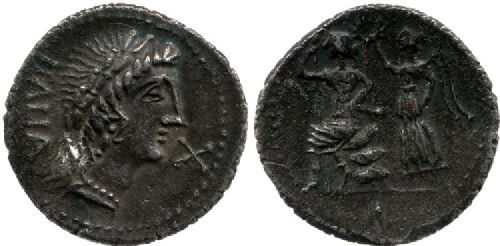 |
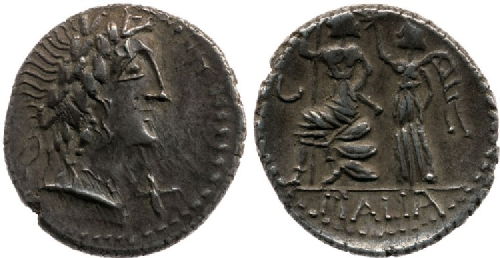 |
|
Denarius of the Italians from the Social War (HN Italy 412a). © The Trustees of the British Museum.
|
Denarius of the Italians from the Social War (HN Italy 412b). © The Trustees of the British Museum.
|
Thus during their rebellion from Roman control the Italians took existing imagery and converted it to support their cause, communciating these new meanings through the clever use and placement of legends. That the Italians felt the need to strike their own coinage demonstrates the role of money in the formulation and expression of identity. These coins and others struck by the Italians represent one of the few pieces of evidence that suggest dissatisfaction with Roman Republican control. The Romans did not take too kindly to this material manifestation of opposition: at the end of the war, it is clear that the coinage of the Italian allies was melted down and converted into Roman denarii. What is left to us today are those coins which were lost before the conclusion of the war, or those which somehow were overlooked during this process.
December 10, 2014
The eagle and the thunderbolt
Writing about web page http://www2.warwick.ac.uk/fac/cross_fac/iatl/funding/fundedprojects/fellowships/rowan/
Something a little different - in the last few weeks, as part of the Hellenistic World module, my students and I have been considering how to represent the ancient world and academic research in new (digital) ways. Here is my first attempt at a Digital story examining the ancient world, incorporating an idea that comes from my research. Enjoy!
https://www.youtube.com/watch?v=CKX0U7arQFw&feature=youtu.be
October 24, 2014
Ambiguity, Roma and Soldiers in Sicily
A picture is less like a statement or speech act, then, than like a speaker capable of an infinite number of utterances. An image is not a text to be read but a ventriloquist's dummy into which we project our own voice.
W.J.T. Mitchell, What Do Pictures Want? p. 140
 |
| 'Zeus / Warrior' Coin from Sicily (Bahrfeldt 2) |
This sentence encompasses the problems of ambiguity and meaning that have been the focus of several previous blogs. Since I posted about the ambiguity of images used by the Romans in Macedonia, I have come across several more examples that show a similar tendency. One is shown to the right, part of the 'Zeus / warrior' coin series struck by the Romans in Sicily. These coins are entangled objects: released by the Romans and carrying references to Roman quaestors in Latin (in this case via the Q for quaestor and a monogram spelling MAL on the far right), the design was likely created by a Greek die engraver, and the coins were intended for circulation within the Roman province of Sicily. Bahrfeldt, acknowledging their mixed nature, termed them 'Roman-Sicilian', a phrase also used by Frey-Kupper in her study of coin circulation in Sicily, which concluded these issues dated to the period 190/170-130/120 BC.
 |
| Coin of Panormos with head of Zeus and Warrior |
Ever since Bahrfeldt's publication, people have wondered 'who' exactly the warrior is. Is it a Roman soldier, a local Greek soldier, or is it the god of war (Mars/Ares)? The Romans might easily have made the picture more 'understandeable' by providing the coin a legend, but here, as with the case of Macedonia, they chose not to. This may have been intentional, allowing, in the words of Mitchell, for each person to 'project their own voice' through seeing their own meaning in the image. In this way, each member of the community that was Roman Republican Sicily might have identified with the image, allowing the image and the coin that bore it to actively generate a shared sense of community. When Panormos began to strike its own coinage bearing its name under Roman dominion from 130/120 BC, they adopt the Zeus / Warrior type. The money created by the conquerors (Rome) has been claimed and adopted by the conquered: 'their' money had become 'our' money. It is in a moment like this that Anderson's 'imagined community' is created. Again, the warrior shown on the coins carrying the ethnic of Panormos may have been Roman, Greek, divine, or as representative of the warriors of Panormos itself. Or it may not even have been seen as a warrior at all.
 |
| Coin of Italica with head of Augustus and Roma |
While we often think of Roma as a seated goddess, some representations of her show her standing with a spear and shield in a very similar manner to the 'warrior' of Sicilian coinage. One example from Spain is shown on the right, which (although it is not visible on this particular specimen) identifies the figure next to the shield as ROMA on the reverse legend (RPC 61). Given this and other examples, could this be another possible reading of the 'warrior' type seen on Roman-Sicilian coinage, the issues of Panormos, and other towns? Just as the image can evoke various soldiers, and perhaps Ares, it may also have been seen as the personification of Roman power itself. But the ambiguity, which still provokes scholarly debate today, was likely the key behind this and other images.
Coin images reproduced courtesy of ArtCoins Roma (Auction 6 lot 257), Classical Numismatic Group (Electronic Auction 327, lot 521) (www.cngcoins.com) and Jesus Vico S.A. (Auction 132, lot 611)
August 13, 2014
Disobedient Objects, Roman Coins and the Battle of Teutoberg Forest
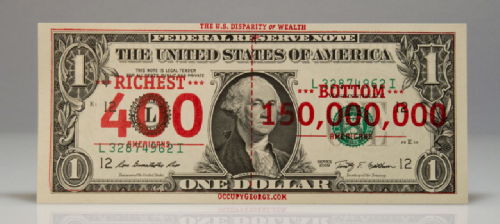 |
| US $1 bill, defaced by an ink stamp. From occupygeorge.com |
Included the Disobedient Objects exhibition currently at the V & A are a series of defaced monetary items, including the US dollar bill above. As material representations of a particular ruling authority that permeate our daily lives, currencies are often used to express dissatisfaction with governmental authorities, or even rebellion. A similar practice also occured in the Roman Empire, when the vast majority of circulating coinage carried the portrait of the emperor, an image that had strong power and charisma. In Roman culture it was vitally important to be remembered after one's death through one's actions and monuments; to destroy a monument or a portrait, then, was to attack the person's very being. (This Roman practice of destroying or defacing an image, whether material or literary, is called damnatio memoriae in modern scholarship).
We find numerous instances of coin mutilation and defacement in the Roman world: coins being slashed, stabbed, subject to graffiti, cut and pierced. If there is no archaeological context, it is difficult to know the motivations behind these actions. In some instances, a coin would be mutilated before being given as an offering to a deity (ensuring that the coin could never again be used for 'profane' commercial transactions, it would always belong to the god or goddess). We do not know the motivations behind the mutilation of the coin below, for example, recently found in Hertfordshire in Britain, and registered on the Portable Antiquities Scheme. But a well-known and clear example of politically motivated currency mutilation can be found at the archaeological site of Kalkriese.
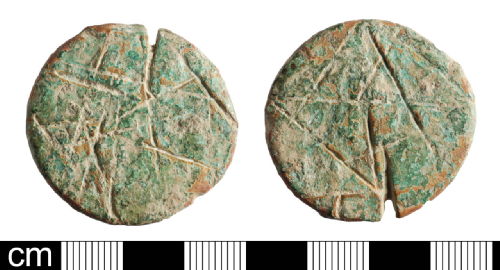 |
| Mutilated Roman Coin. (PAS BH-57-3B8). |
The site of Kalkriese was the site of a battle between Roman and German forces in the early first century AD. Though not universally accepted, many identify the site as the location of the Battle of Teutoberg Forest, in which the Roman general Varus was horribly defeated by the Germans in AD 9, losing several legions and cohorts. Amongst the finds on this ancient battlefield are numerous coins, with a large number of Augustan small bronze coins (called asses) from the mint at Lugdunum (Lyons). A significant proportion of these asses were defaced by stabbing, cuts or slashes. The original publication of these coins argued that these actions were performed by dissatisfied Roman troops (Berger). More recently, Kemmers and Myberg have suggested that the Germans may have been responsible: after defeating the Romans, the Germans then went on to deface one of the most potent symbols of Roman imperial power. Interpretation remains open, but the finds indicate that the coins must have been carried onto battlefield by the Romans. In this case it is perhaps unlikely that Roman troops were responsible for the mutilation - after the defacement the coins would no longer have been considered valid currency and there would be little reason for a Roman to be carrying them around, particularly into battle. The mutilation might thus have occured as part of the German post-battle victory celebrations.
For more on the defaced currrencies currently on display in London see this post. For the coins at Kalkriese see F. Berger, (1996). Kalkriese 1: Die römische Fundmünzen. Mainz; and F. Kemmers, F. and N. Myberg (2011). "Rethinking numismatics. The archaeology of coins." Archaeological Dialogues 18: 87-108.
June 11, 2014
Entangled Objects, British Nationalism and the Elgin Marbles
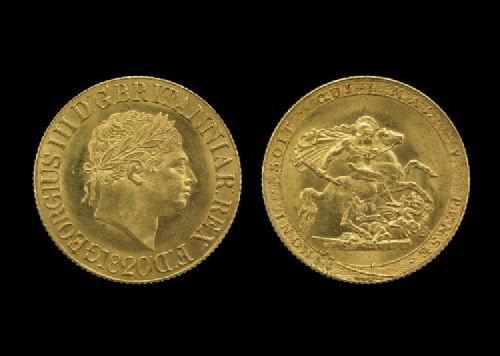 |
| Sovereign of George III |
Over the last week or so I have been doing a lot of thinking about the role that images and material objects play in constructing identities, communities, empires and nations. A more modern example that I think demonstrates the sort of phenomenon we might also look for in the ancient Roman world is the Elgin marbles, the parthenon frieze taken from Athens to London by Lord Elgin at the beginning of the nineteenth century.
Few people realise I think (and I didn't until last week) that when the marbles arrived, the British government believed they were worthless, and refused to buy them (a good cartoon demonstrating the general sentiment can be found here). Lord Elgin and his friends thus had to wage something of a publicity campaign to ensure that his investment would pay off, a campaign that was apparently waged from Elgin's backyard shed, where the marbles were temporarily housed. But what it interesting is that the marbles arrived just as Britain was attempting to articulate its identity as a nation and as an Empire, and the marbles became an object that featured in these discussions. Since the images on the parthenon marbles are a bit ambiguous (there is still discussion over their exact meaning), people could see in the marbles differing ideas of British identity: British masculine superiority, the power of the British war machine, the idea of elite cavalry, the British male body, and the fact that the marbles were monochrome meant that they could even be used to discuss ideas of white superiority. (An excellent discussion of all of this can be found in Rose-Greenland, F. (2013). "The Parthenon marbles as icons of nationalism in nineteenth-century Britain." Nations and Nationalism 19: 654-673.)
What I find interesting is how these particular objects played an active role in forming British identity, and that the formation of this ideas took place not in the government, but among the elite (Elgin and his friends). Moreover, when a new coin design was introduced under George III in 1818 (for the earlier coinage design see here), the marbles served as direct inspiration. The Greek imagery, however, has been adapted to its British context in that the Greek-style figure is now slaying a dragon, a reference to St. George. These objects then, brought from outside Britain, played an active role in forming British identity and, in the end, epitomised a new idea of Britain on a new style of coinage (tellingly called 'a sovereign'). The question is, why did the marbles act in this way, out of ALL the objects that came into London in this period? I wonder if it has something to do with the ambiguity of the imagery of the marbles, meaning that they were susceptible to multiple meanings and interpretations in a way that other objects were not. (I have, of course, blogged on ambiguity before).The Elgin marbles also raises the question as to how other 'entangled objects' may have influenced the formation of Roman identity, and, ultimately, the design of coinage under Roman dominion. And, given the ongoing discussion over British identity in the modern day, it makes me wonder what will be chosen for the new British one pound coin.
(Image above is © The Trustees of the British Museum. See the coin online here.)
March 18, 2014
The Many Faces of Augustus
 |
| Spanish coin showing Augustus and shield |
During the period in which Augustus came to hold sole power in the Roman Empire, the minting of Roman coinage was decentralised. Instead of coinage only being struck at Rome, different generals and Roman officers struck Roman denarii at a series of different mints throughout the Empire. Indeed, coinage was probably only struck in Rome again from c. 19 BC. This means that in the period after Actium, the coinage of Augustus was struck in a variety of different mints, which meant that the image and associations of Augustus and his rule had regional differences, at least initially.
The decentralised nature of minting in this period also meant that there was the possibility for official images of Augustus to become 'entangled' with local iconographies - that is, for Roman officials and mints to take inspiration from local currency designs, either as a way of communicating Augustus' power to local populations, or as a strategy to make the currency more acceptable. Several interesting coin designs have resulted from this process, one of which is a series of coins struck in an uncertain mint in Spain (RPC 1 1-4). This coinage lacks the name of a city, and so is probably an imperial series of Augustus, although it is not listed as such in the catalogue of Roman Imperial Coinage. On this series Augustus is presented as the son of the divine Julius Caesar (IMP AVG DIVI F), and his portrait is accompanied by a palm branch and winged caduceus. These two attributes were commonly seen on the local coins struck in Spain (Iberia); the palm branch is often shown being held by a horse rider (see one example here), and the winged caduceus appears on the coinage of several cities (e.g. as a reverse type, or being held by the Tyche of a Spanish city on a coin series struck by Sextus Pompey).
 |
| Similar coin, but with dagger and Iberian sword |
The image of Augustus presented here is thus one with a particular 'Iberian' flair. This is further suggested by the reverses of this coin series, which show an Iberian shield, sometimes accompanied by a dagger and Iberian sword. These coins are mostly found in NW Spain, meaning that the image and associations of Augustus in this region would likely have been different to that found in the East of the Empire, for example, or even in Gaul. Augustus presented many faces to different audiences, as he and his subordinates sought to communicate the new power structure to the broader Roman Empire.
(Coin images reproduced courtesy of Classical Numismatic Group Inc., www.cngcoins.com)
February 13, 2014
Succession and the Aurei of Mark Antony
 |
| Aureus showing Antony and his son Antyllus |
The problem of succession, and Augustus' means of communicating succession, form a key theme in the study of the Augustan principate. But the mechanisms for communicating succession and dynasty in the principate arose directly out of the Republic, in particular the strategies employed during the civil wars. We can see this in a gold aureus series struck for Mark Antony in 34 BC while he was triumvir in the East (RRC 541/1-2). The design of this series foreshadows how imperial dynasty and succession would later be communicated during the Roman Empire.
The coin issue consisted of two different types, but both of them carried the portrait of Mark Antony on the obverse and the portrait of his eldest son Marcus Antonius Antyllus on the reverse. Antyllus was the child of Antony and Fulvia, and was at one point engaged to Octavian's daughter Julia. His appearance on coinage here suggests that Antony may have been attempting to establish and advertise a successor, well before Augustus would later turn to the problem.
This is also suggested by the legends of these pieces. On the first type, the titles of Antony occupy both the obverse and reverse of the coin (M ANTONI M F M N AVG IMP TERT, COS ITER DESIG TERT III VIR R P C, Marcus Antonius, son of Marcus, grandson of Marcus, Augur, Imperator for the third time, consul for the second time, consul designate for the third time, triumvir for the establishment of the Republic). That Antony included the names of his father and grandfather must have been intentional: in contrast to Octavian's claims to be the son of the divine Caesar, Antony represents his descent in a traditional Roman manner, something which may have appealed to the Senate rather more than Octavian's claims. One the second type of this issue (shown above), Antony's titles are abbreviated and confined to the obverse of the coin, while the reverse carries the name of Marcus Antonius Antyllus, who is presented as the son of Antony (M ANTONIVS M F F). Thus over both types, Antony and his positions are communicated, as is Antony's ancestry and his successor, a presentation that is remarkably similar to what would occur later in the imperial period.
Coin image reproduced courtesy of Numismatica Ars Classica NAC AG (Auction 54, Lot 285)
January 24, 2014
Sosius, Zacynthus, and the Temple of Apollo Sosianus in Rome
 |
| Coins of Sosius from Zacynthus |
Gaius Sosius, one of Mark Antony's generals, provides an excellent example of the role played by individuals other than the triumvirs in the civil wars at the end of the Republic. Sosius, who was governor of Syria and Cilicia in 38 BC and assisted in placing King Herod on the throne, was a staunch supporter of Antony, and was in a position of some power at Antony's naval base at Zacynthus. We know this because between 39 BC (when the base was founded) and 32 BC, a series of coins were struck under Sosius' authority (RPC 1 1290-3).
The obverse of the first two coins carries the portrait of Antony. The reverse of issue 1 bears a Ptolemaic eagle, a reference to Antony's alliance with Cleopatra. The second issue, struck in 36 BC, names Sosius as imperator and carries a military trophy on the reverse, a reference to Sosius' victory in Judea. It is unusual that Sosius uses his coinage to advertise his own personal achievements rather than that of the triumvirs, though the portrait of Antony on the obverse underlines the fact that Sosius was acting under Antony's support and patronage.
 |
| Temple of Apollo Sosianus |
The third issue carries the head of Apollo on the obverse, and a tripod on the reverse. Sosius is named as consul designate. The imagery is identical to the pre-Roman local coinage of the island, which had a famous cult to Apollo. But after his triumph in Rome in 34 BC (for his victories in Judea), Sosius vowed to rebuild the temple of Apollo in the Campus Martius, today known as the temple of Apollo Sosianus. The declaration that a supporter of Antony was rebuilding a temple to Apollo in Rome, soon after Octavian had vowed his famous Apolline temple on the Palatine, was a powerful statement. It may be that this third issue of Sosius references his building activities in Rome, and the Roman general adopted local iconography to communicate his message. The users of the coin may have seen either a reference to the local cult of Apollo and local coinage, or a broader reference to Sosius' activities, or both.
The fourth coin, which carries a head of Neptune on the obverse and a dolphin and trident on the reverse, was struck after Sosius had fled Rome early in his consulship in 32 BC, and references his position as a commander of Antony's fleet just before Actium. Although Sosius fled the capital only a few days or weeks into his consulship, the coin still names him as consul, indicating that both he and Antony believed he still held the position.
(Coin images reproduced from Bahrfehldt, JIAN 11 (1908), pl. XIII)
November 21, 2013
Creating Colonies: Tradition and Community Formation in Lugdunum and Corinth
 |
| Quinarius in the name of Antony, struck at Lugdunum |
In 43 BC Lucius Munatius Plancus founded the colony of Lugdunum, modern day Lyon. As was common practice in other Roman colonial foundations, coinage was struck to mark the occasion. For many colonies, this was the only time local coinage was minted: the Romans may have seen the provision of local coinage in this context as a necessity, not only to facilitate exchange, but to build a sense of common identity amongst disparate settlers. A local currency that bore imagery associated with the foundation could contribute to a sense of community. In the case of Lugdunum, the imagery selected demonstrates the Roman awareness of the different currencies in the regions under their control.
Two silver quinarii coins were struck in 43-42 BC in connection with the founding of the colony. One was issued in the name of the colony, and the other bearing the titles of the triumvir Mark Antony (Plancus was a supporter of Antony until Antony's failed campaign against the Parthians). The obverse of these coins bore an image of Victory, while the reverse displayed a lion. The choice of the rare quinarius denomination, and the iconography, must have been in deference to the local traditions of currency within the region: small silver coinage was used more often in Gaul than in Rome, and the iconography of the lion refers to one of the most common currencies in the region before the Roman conquest: the coinage of Massalia (modern day Marseilles). The particular way Victory is represented on the obverse of the coin series (with her wings coming up at either side of her bust) may also reference Massalian coinage, which shows Artemis with a bow and quiver in a similar fashion.
 |
| Coin of Massalia showing Artemis and lion |
That a series was struck in the name of Antony, and another in the name of Lugdunum, demonstrates that in the Late Republic coin imagery did not always reflect contemporary political concerns. Rather here, and elsewhere, the Romans acknowledged and responded to local currencies. This would have made the acceptance of the currency amongst the existing population much easier, but the iconography of Massalia was transferred to the new colony of Lugdunum. In modern colonial situations, the continuation of a local currency is often an act of resistance against the new power (e.g. the persistence of cattle currency, or cowry shells), forcing the dominant power to react, often by tacitly allowing the old forms of currency to continue. We cannot know whether this was the case here, but the result is a coinage whose iconography simultaneously references Massalia, Lugdunum, and Roman power via Mark Antony. It is another example of the entangled nature of imagery and ideology that developed during the formation of the Roman Empire.
The reference to pre-existing local currency is also seen in the late Republican colonial foundation of Corinth, founded by Julius Caesar in 44 BC. Excavations at Corinth have revealed that a significant portion of the circulating small change in the city were the coins of Corinth struck before her destruction in 146 BC (how these coins reappeared in a colony founded more than 100 years later is an intriguing but perhaps unanswerable question). These types carried a trident on the obverse and pegasus on the reverse. The precise imagery was later struck by civic magistrates within the city, again probably in reference to the persistance of local monetary traditions. In both Lugdunum and Corinth, the numismatic imagery selected for the settlements referenced local traditions, although the settlers would have come from disparate geographical regions.
(Images reproduced courtesy of Numismatica Ars Classica NAC AG (Auction 63, Lot 483), and Classical Numismatic Group Inc., (Electronic Auction 264, lot 1, www.cngcoins.com))
October 16, 2013
The Metelli, Macedonian Shields and the Appropriation of Images
 |
| Coin with Macedonian shield and prow |
Carr's study of the German occupation of the Channel Islands during WWII has demonstrated that numismatic iconography became the focus of differing claims and associations. Local islanders used the imagery of their coinage (the king's portrait and local crests) as symbols of resistance against the Germans, and as symbols of local identity. Simultaneously, Germans increasingly saw the imagery as rightfully 'theirs', since, having conquered the region, they had, in a sense, also conquered and won its iconography. Local coins were sent back to Germany as souvenirs, or fashioned into trench art.
The study forces us to think about the possible, mutually incompatable, associations particular imagery may have had. When the Romans conquered a particular region, did they also 'conquer' its iconography? One example demonstrates that this may also have been the case in antiquity. One of the key icons of Hellenistic Macedonia was the Macedonian shield, which featured on the coinage of the region (see the Figure above, a silver coin showing the Macedonian shield on the obverse and the prow of a ship on the reverse, struck in the period 187-168 BC, just before the Roman conquest).
 |
| Coin of M. Caecilius Q.f. Q.n. Metellus |
After the Roman conquest of Macedonia, these shields appear in various Roman monuments and contexts (e.g. the monument erected for Aemilius Paullus in Delphi), and Livy records that Macedonian shields were actually brought back to Rome and paraded in triumph (45.35.3). This suggests that the 'icon' of this region had been conquered by Rome. The coinage of the Metelli family also suggests that the Macedonian shield was appropriated by the gens after the victory of Q. Caecilius Metellus Macedonicus in Macedonia in 148 BC. The shield appears on coins struck by the descendants of Q. Caecilius Metellus, suggesting that the imagery had been appropriated by the family as the spoils of victory. This is underlined by the fact that the Macedonian shield now appears with the head of an elephant in the centre: this was a sign associated with the Metelli family, and its addition to the shield here can be read as a further act of appropriation. (The example shown shows Roma on the obverse and was struck in 127 BC).
Thus both Macedonians and Romans (especially the Metelli) may have seen the iconography of the Macedonian shield as rightfully 'theirs'. The image of the shield therefore sat somewhere in between the two cultures, and might be read as a reference to Macedonia, the Metelli family, or both. 'Macedonian' imagery may not always have remained 'Macedonian'.
For those interested, Carr's article is: G. Carr, (2012). Coins, crests and kings: symbols of identity and resistance in the Occupied Channel Islands. Journal of Material Culture, 17, 327-44.
The coin images are reproduced courtesy of Classical Numismatic Group Inc., (Electronic Auction 261, lot 50 and Electronic Auction 157 lot 132) (www.cngcoins.com)
 Clare Rowan
Clare Rowan

 Please wait - comments are loading
Please wait - comments are loading

 Loading…
Loading…

